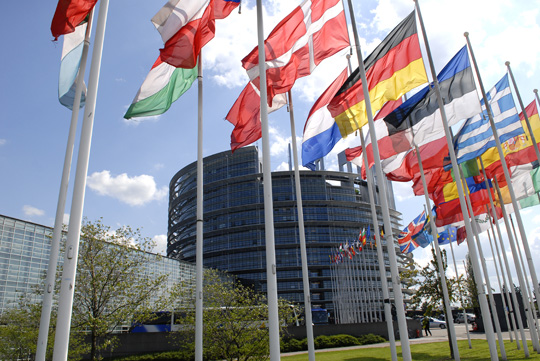Europe, swipe and there you have it
Freiburg, May 13, 2019
Should the European Union be able to levy its own taxes, should the euro be abolished as a common currency? Voters can find answers to these questions and more that the parties taking part in the European elections on May 26 offer in a new online tool, the "VoteSwiper", designed by Freiburg political scientist Prof. Dr. Uwe Wagschal. In this way they can determine which party they most agree with in order to make a conscious choice on the ballot paper. But they can also look around the European election programs of parties from other EU countries, with which their own MEPs will cooperate in the transnational groups of the European Parliament. Verena Adt spoke with Uwe Wagschal about the new decision-making tool.
 EU voters will decide on the new composition of the European Parliament on May 26, 2019: Uwe Wagschal wants to use his online tool "VoteSwiper" to inform many people in advance about the most important topics of this election. Photo: European Parliament
EU voters will decide on the new composition of the European Parliament on May 26, 2019: Uwe Wagschal wants to use his online tool "VoteSwiper" to inform many people in advance about the most important topics of this election. Photo: European Parliament
Mr. Wagschal, You have already helped to develop electoral assistance tools for several state elections in Germany. What is new about the "VoteSwiper" that you have now created for the European elections?
Uwe Wagschal: We offer the "VoteSwiper" in at least five EU countries with largely identical questions. It was an important goal for us to be able to compare the EU countries. That's why over 80 percent of the questions that users answer to determine their position in relation to the parties' programming are the same in all countries. It is the only way to make a comparison between the countries, and we think that this would be useful in a European election. Of a total of 30 questions, only five are specific to the respective country.
What kind of country-specific questions does the app pose?
The five country-specific questions address topics that are currently being discussed politically in the respective country and have a European dimension. In Germany, for example, it is the question of whether the country should advocate a Europe-wide ban on glyphosate; in France, for example, it is the need for a common European corporate taxation system.
And which questions are the same for every country?
Of the 30 overall questions, 20 questions are explicitly related to Europe. For example, whether the European Union should have a eurozone budget with its own European finance minister or whether the EU should ban research using human embryos. Then there are five more questions that focus on the countries and are the same for all of them. For example, whether Germany - or France or Sweden, or the country in question - should again carry out its own border controls, or whether it should advocate the abolition of Russia's sanctions.
How did you solve the language issue?
We offer the "VoteSwiper" in the languages of all participating countries. In addition, each national survey is also available in German, French and English. Someone in Germany, for example, can look at the positions of the Hungarian or Polish parties on the various questions in German. This is not only of theoretical interest, because the members of the European Parliament elected by the German voters work in joint parliamentary groups with party representatives from many other EU states. And as can be seen in the election agendas, the parties in a parliamentary group do not have homogeneous positions on all issues. For a German CDU voter, for example, it can be very interesting to see what the Hungarian Fides party, which sits in the European Parliament in a parliamentary group with the CDU/CSU, wants.
 Uwe Wagschal is pursuing two goals with the development of the "VoteSwiper": Based on the answers of the parties, he can scientifically investigate similarities and differences between the parties. He also wants to increase the recent decline in voter turnout. Photo: Jürgen Gocke
Uwe Wagschal is pursuing two goals with the development of the "VoteSwiper": Based on the answers of the parties, he can scientifically investigate similarities and differences between the parties. He also wants to increase the recent decline in voter turnout. Photo: Jürgen Gocke
How were the lists of questions developed?
From a scientific point of view, this is the most exciting question: Which topics are covered? People can look at questions such as what is current, what is the subject of much discussion at European level? What do the parties say? We look at the parties' European election agendas and the press. Here we have our team, experienced from previous projects, and we have volunteers in every country who work with us.
Why aren’t all 28 EU member states included?
It has to do with funding. We asked various pro-European institutions whether they wanted to make a financial contribution, but none wanted to support us. We work on a volunteer basis. We provide the content structure here in Freiburg free of charge while the technical competence and server costs are provided by the Berlin start-up Movact. The tool has a very modern design. You swipe through the program and no longer click, and there is also the possibility to insert short explanatory videos. Unfortunately, we couldn't make any videos in the end due to VoteSwiper’s lack of funding.
Who would be interested in such an online offering to make an informed voting decision?
The range is very extensive. We had 500,000 participants in the 2017 Bundestag elections and our goal for the European elections is one million. In the small federal state of Bremen, more than 4,000 participants used the app to vote for municipal elections in the first 24 hours. The users are by no means just young people. The average age of the users of our "VoteSwipers" was between 40 and 50 years in the state parliament election in Hesse, where we carried out an evaluation. And the 50 to 60-year-olds are also well represented. There is a tendency to think that it only addresses young people, but that's not been the case.
Which objectives are you pursuing with the development of the "VoteSwiper"?
We have two interests. The first is a scientific one. These data can be used well to investigate similarities and differences between parties. For example, are social democrats in France similar to those in Germany? How is the Green Party camp set up across the different countries? What are the positions in Eastern Europe compared to Western Europe, in Northern Europe compared to Southern Europe? Of the 160 or 170 parties represented in the European Parliament, 60 to 70 will be able to compare point by point at the end.
And the second objective?
First of all, there is the issue of voter turnout. Voter turnout in the European elections has declined and has recently been well below 50 percent. Our tool can definitely be useful here. We can reach a much wider audience than the viewers of political channels such as Phoenix. We reach young people and also people who may not initially be interested in the European elections, but who become aware of them through social media and other dialogue about our application. Our experience is that many people post their own evaluation on social media, which has a snowball effect. But we also want to inform about Europe, the important issues there and how the parties feel about it. If someone reads thirty questions about Europe and reflects on his answers to them, much has already been gained.

